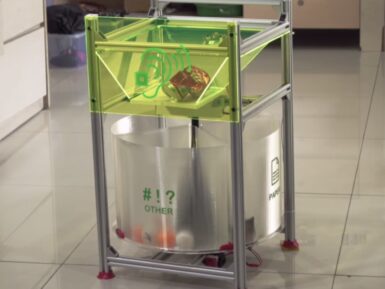
Overview
This Dust Sensor gives a good indication of the air quality in an environment by measuring the dust concentration. The Particulate Matter level (PM level) in the air is measured by counting the Low Pulse Occupancy time (LPO time) in given time unit. LPO time is proportional to PM concentration.
This sensor can provide reliable data for air purifier systems; it is responsive to PM of diameter 1μm.
Note: This sensor uses counting method to measure dust concentration, not weighing method, and the unit is pcs/L or pcs/0.01cf.
Tech specs
|
Item |
Norm |
Unit |
|
VCC |
4.75~5.75 |
V |
|
Standby Current Supply |
90 |
mA |
|
Detectable range of concentration |
0~28,000 / 0 ~ 8000 |
pcs/liter / pcs/0.01cf |
|
Operating Temperature Range |
0~45 |
°C |
|
Output Method |
Negative Logic, Digital output, High: over 4.0V(Rev.2), Low: under 0.7V |
- |
|
Detecting the particle diameter |
>1 |
μm |
|
Dimensions |
59(W) × 45(H) × 22(D) |
mm |
|
Humidity Range |
95% rh or less |
- |
Pinmaping
|
Arduino UNO |
Dust Sensor Pin |
Cable Color |
|
5V |
Pin 3 |
Red wire |
|
GND |
Pin 1 |
Black wire |
|
D8 |
Pin 4 |
Yellow wire |
Get Inspired

Debug your C33 with few steps

In July 2023, Samuel Alexander set out to reduce the amount of trash that gets thrown out due to poor sorting practices at the recycling bin. His original design relied on an Arduino Nano 33 BLE Sense to capture audio through its onboard microphone and then perform edge audio classification with an embedded ML model to automatically separate materials based on the sound they make when tossed inside. But in this latest iteration, Alexander added several large improvements to help the concept scale much further. Perhaps the most substantial modification, the bin now uses an Arduino Pro Portenta C33 in combination with an external Nicla Voice or Nano 33 BLE Sense to not only perform inferences to sort trash, but also send real-time data to a cloud endpoint. By utilizing the Arduino Cloud through the Portanta C33, each AI-enabled recycling bin can now report its current capacity for each type of waste and then send an alert when collection must occur. While not as practical for household use, this integration could be incredibly effective for municipalities looking to create a network of bins that can be deployed in a city park environment or another public space. Thanks to these upgrades, Alexander was able to submit his prototype for consideration in the 2023 Hackaday Prize competition where he was awarded the Protolabs manufacturing grant. To see more about this innovative project, you can check out its write-up here and watch Alexander’s detailed explanation video below.






